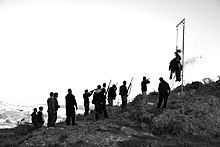

The burning of Judas is an Easter-time ritual that originated in European[1] Christian communities where an effigy of Judas Iscariot is burned. Other related mistreatment of Judas effigies include hanging, flogging, and exploding with fireworks.[2][3] A similar ritual in Jewish tradition would be the hanging and burning an effigy of Haman and his ten sons during Purim, although this is not a widespread contemporary practice.[4][5]
Though not an official part of the Easter liturgical cycle, the custom is typically a part of the reenactment of the story of the Passion that is practiced by the faithful during Easter. Customs vary, but the effigy of Judas is typically hanged (reenacting Matthew 27:5) on Good Friday, then burned on the night of Easter Sunday.
In many parts of Latin America this practice occurs on the eve of the New Year as a symbol of ridding one's self of evil and beginning a new year in spiritual purity. Some communities observe this ritual using various effigies, including the biblical Judas (who betrayed Jesus). This custom, during which the effigy is burned on a stake, is called "Quema del Judas" ("the burning of Judas") in Uruguay and Argentina, and "Quema del Año Viejo" ("the burning of the old year")[6] in other places.
- ^ Pedelty, Mark (2009-06-03). Musical Ritual in Mexico City: From the Aztec to NAFTA. University of Texas Press. ISBN 9780292774186.
- ^ Doane, William Croswell (30 October 2018). "The Book of Easter". Macmillan – via Google Books.
- ^ F.F.T. (1902-02-09). "Lenten Days In Mexico. - Curious Customs To Be Seen This Week In The Land Of Montezuma. - Article - Nytimes.Com". New York Times. Retrieved 2013-03-04.
- ^ Sandrow, Nahma (1996). Vagabond Stars: A World History of Yiddish Theater. Syracuse University Press. ISBN 9780815603290.
Sometimes they went outside the city gates, carrying a dummy representing Haman, whom they hanged in effigy and burned in a bonfire
- ^ Kerler, Dov-Ber (2000-01-01). Politics of Yiddish: Studies in Language, Literature and Society. Rowman Altamira. ISBN 9780585223575.
There is some evidence Of the hanging and burning of the Haman effigy in the midst of song and dance lasting well past the Middle Ages
- ^ es:Año viejo